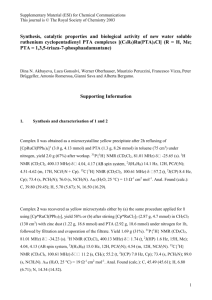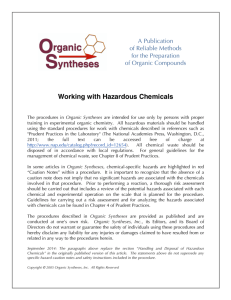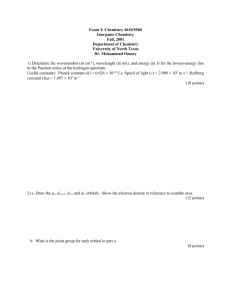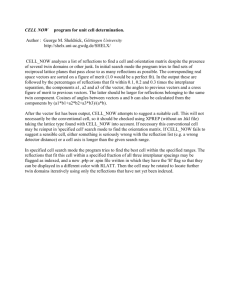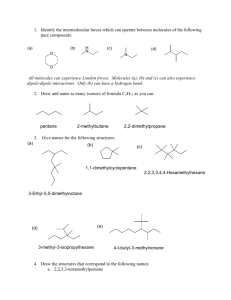Structure of Bis-/z3-phenylimido-tris(tricarbonylruthenium), [Ru3
advertisement
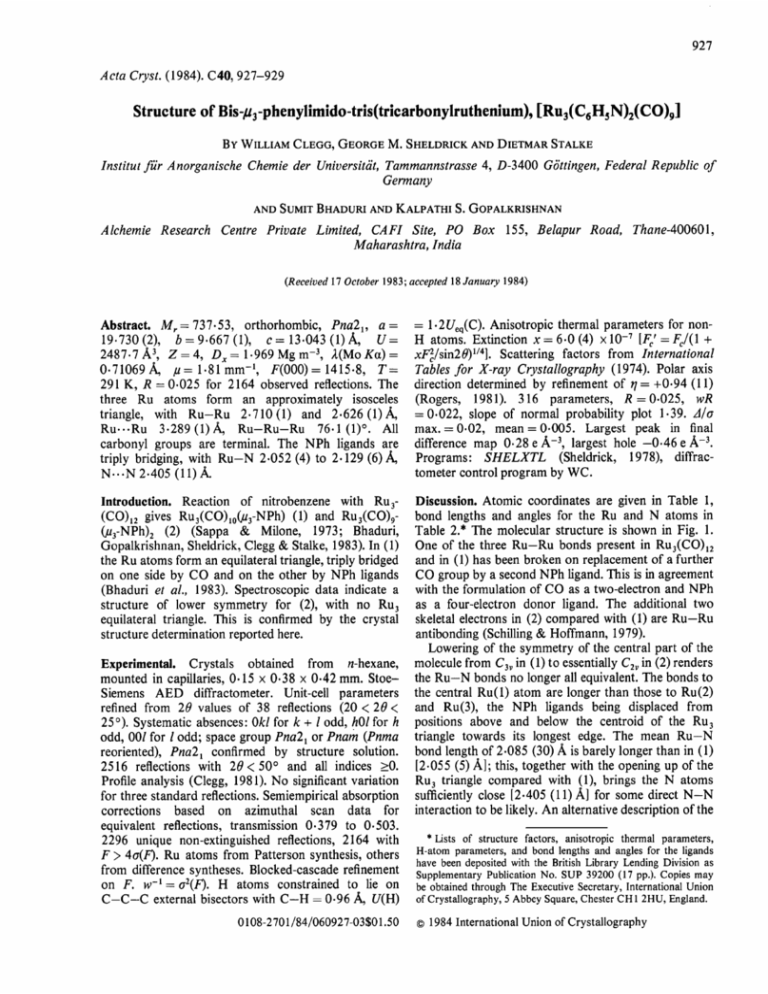
927 Aeta Cryst. (1984). C40, 927-929 Structure of Bis-/z3-phenylimido-tris(tricarbonylruthenium), [Ru3(C6HsN)2(CO)9] BY WILLIAM CLEGG, GEORGE M. SHELDRICK AND DIETMAR STALKE Institut fib" Anorganische Chemie der Universiti~'t, Tammannstrasse 4, D-3400 Gb'ttingen, Federal Republic of Germany AND SUMIT BHADURI AND KALPATHI S. GOPALKRISHNAN Alchemic Research Centre Private Limited, CAFI Site, PO Box 155, Belapur Road, Thane-400601, Maharashtra, India (Received 17 October 1983; accepted 18January 1984) Abstract. M r = 7 3 7 . 5 3 , orthorhombic, Pna2~, a = 19.730(2), b - - 9 . 6 6 7 ( 1 ) , c=13.043(1)A, U= 2487.7 ,/~a, Z = 4, D x = 1.969 Mg m -a, 2(Mo Ka) = 0.71069 A, # = 1.81mm -1, F ( 0 0 0 ) = 1415.8, T = 291 K, R = 0.025 for 2164 observed reflections. The three Ru atoms form an approximately isosceles triangle, with R u - R u 2.710(1) and 2.626(1)]L, Ru...Ru 3.289(1)/L, Ru--Ru--Ru 76.1 (1)% All carbonyl groups are terminal. The NPh ligands are triply bridging, with R u - N 2.052 (4) to 2.129 (6) A, N . . . N 2.405 (11)/k. = 1.2Ueq(C ). Anisotropic thermal parameters for nonH atoms. Extinction x = 6.0 (4) x 10 -7 [Fc' = F c~(1 + xF~c/sin20)l/4]. Scattering factors from International Tables for X-ray Crystallography (1974). Polar axis direction determined by refinement of r/= +0.94 (1 l) (Rogers, 1981). 316 parameters, R = 0 . 0 2 5 , wR = 0.022, slope of normal probability plot 1.39. A/cr max.--0.02, m e a n = 0 . 0 0 5 . Largest peak in final difference map 0.28 e/k -3, largest hole - 0 . 4 6 e/k -a. Programs: S H E L X T L (Sheldrick, 1978), diffractometer control program by WC. Introduction. Reaction of nitrobenzene with Discussion. Atomic coordinates are given in Table 1, bond lengths and angles for the Ru and N atoms in Table 2.* The molecular structure is shown in Fig. 1. One of the three Ru--Ru bonds present in Ru3(CO)I 2 and in (1) has been broken on replacement of a further CO group by a second NPh ligand. This is in agreement with the formulation of CO as a two-electron and NPh as a four-electron donor ligand. The additional two skeletal electrons in (2) compared with (1) are R u - R u antibonding (Schilling & Hoffmann, 1979). Lowering of the symmetry of the central part of the molecule from C3v in (1) to essentially C2v in (2) renders the R u - N bonds no longer all equivalent. The bonds to the central Ru(1) atom are longer than those to Ru(2) and Ru(3), the NPh ligands being displaced from positions above and below the centroid of the Ru 3 triangle towards its longest edge. The mean R u - N bond length of 2.085 (30) A is barely longer than in (1) [2.055 (5)/k]; this, together with the opening up of the Ru a triangle compared with (1), brings the N atoms sufficiently close [2.405 (11)/~] for some direct N - N interaction to be likely. An alternative description of the Ru 3- (CO)t2 gives Ru3(CO)10(,u3-NPh) (1) and Ru3(CO) 9(P3-NPh)2 (2) (Sappa & Milone, 1973; Bhaduri, Gopalkrishnan, Sheldrick, Clegg & Stalke, 1983). In (1) the Ru atoms form an equilateral triangle, triply bridged on one side by CO and on the other by NPh ligands (Bhaduri et al., 1983). Spectroscopic data indicate a structure of lower symmetry for (2), with no Ru 3 equilateral triangle. This is confirmed by the crystal structure determination reported here. Experimental. Crystals obtained from n-hexane, mounted in capillaries, 0.15 × 0.38 x 0.42 mm. StoeSiemens AED diffractometer. Unit-cell parameters refined from 2t9 values of 38 reflections (20 < 2 0 < 25°). Systematic absences: Okl for k + l odd, hOl for h odd, 00l for I odd; space group Pna21 or Pnam (Pnma reoriented), Pna2~ confirmed by structure solution. 2516 reflections with 2 0 < 50 ° and all indices >0. Profile analysis (Clegg, 1981). No significant variation for three standard reflections. Semiempirical absorption corrections based on azimuthal scan data for equivalent reflections, transmission 0.379 to 0.503. 2296 unique non-extinguished reflections, 2164 with F > 4tr(F). Ru atoms from Patterson synthesis, others from difference syntheses. Blocked-cascade refinement on F. w - l = cr2(F). H atoms constrained to lie on C - C - C external bisectors with C - H = 0.96 A, U(H) 0108-2701/84/060927-03501.50 * Lists of structure factors, anisotropic thermal parameters, H-atom parameters, and bond lengths and angles for the ligands have been deposited with the British Library Lending Division as Supplementary Publication No. SUP 39200 (17 pp.). Copies may be obtained through The Executive Secretary, International Union of Crystallography, 5 Abbey Square, Chester CH 1 2HU, England. © 1984 International Union of Crystallography BIS-g3-PHENYLIMIDO-TRIS (TRICARB ONYLRUTHENIUM) 928 Table 1. Atomic coordinates ( x l 0 4) and equivalent isotropic thermalparameters (,/k 2 x 103) The equivalentisotropic U is defined as one third of the trace of the orthogonalized Uu tensor. x 1352 (1) 2127 (1) 1142 (1) 1511 (4) 1601 (3) 462 (4) -72 (3) 1765 (4) 1976 (3) 2388 (3) 2537 (3) 3055 (4) 3596 (3) 2013 (3) 1979 (3) 184 (3) -379 (2) 1349 (4) 1483 (3) 1234 (3) 1259 (3) 2060 (2) 2645 (3) 2818 (3) 3387 (4) 3783 (3) 3629 (4) 3052 (3) 1124 (2) 597 (3) 419 (4) -91 (5) -441 (5) -280 (4) 243 (3) Ru(l) Ru(2) Ru(3) C(11) O(11) C(12) O(12) C(13) O(13) C(21) O(21) C(22) 0(22) C(23) 0(23) C(31) O(31) C(32) 0(32) C(33) 0(33) N(4) C(41) C(42) C(43) C(44) C(45) C(46) N(5) C(51) C(52) C(53) C(54) C(55) C(56) y 1549 (1) 2473 (1) -269 (1) 387 (7) -342 (6) 2003 (8) 2233 (8) 3152 (7) 4056 (5) 2079 (6) 1837 (5) 2889 (7) 3132 (7) 4404 (7) 5526 (4) -544 (6) -710 (6) -915 (8) -1318 (8) -2041 (7) -3083 (5) 529 (4) -259 (6) -1431 (6) -2207 (8) -1798 (8) -631 (7) 120 (6) 1876 (4) 2710 (7) 3966 (7) 4764 (11) 4285 (11) 3083 (11) 2267 (9) 0t221~ c~_ C(461,e o~, 01331 U 39 (1) 41 (1) 45 (1) 58 (2) 98 (2) 78 (3) 135 (4) 60 (2) 100 (3) 50 (2) 78 (2) 58 (2) 96 (3) 58 (2) 88 (2) 72 (3) 113 (3) 74 (3) 122 (3) 60 (2) 87 (2) 39 (1) 44 (2) 58 (2) 80 (3) 84 (3) 73 (3) 54 (2) 47 (I) 60 (2) 89 (3) 135 (5) 150 (6) 123 (5) 85 (3) Ru(1)-Ru(2) 2.710 (1) Ru(1)--C(II) Ru(I)-C(13) Ru(I)-N(5) 1.903(6) 2.129 (6) Ru(2)-C(22) Ru(2)-N(4) Ru(3)-C(31) Ru(3)-C(33) Ru(3)-N(5) N(5)-C(51) 1.945 2.052 1.918 1.917 2.079 1.418 1.912 (6) Ru(2)--Ru(l)-Ru(3) Ru(3)---Ru(1)-C(11) Ru(3)-Ru(l)--C(12) Ru(2)-Ru(1)---C(13) C(I l)-Ru(l)--C(13) Ru(2)-Ru(I)-N(4) C(I I)---Ru(I)-N(4) C(13)-Ru(I)-N(4) Ru(3)-Ru(1)-N(5) C(12)--Ru(I)--N(5) N(4)-Ru(I)--N(5) Ru(1)-Ru(2)--C(22) Ru(I)-Ru(2)--C(23) C(22)-Ru(2)--C(23) C(2 I)--Ru(2)-N(4) C(23)-Ru(2)-N(4) C(21)--Ru(2)-N(5) C(23)--Ru(2)-N(5) Ru(I)--Ru(3)-C(31) C(31)--Ru(3)-C(32) C(31)---Ru(3)--C(33) Ru(I)--Ru(3)--N(4) C(32)-Ru(3)---N(4) Ru(I)-Ru(3)--N(5) C(32)-Ru(3)--N(5) N(4)-Ru(3)-N(5) Ru(1)-N(4)-Ru(3) Ru(I)---N(4)-C(41) Ru(3)--N(4)-C(41) Ru(I)--N(5)-Ru(3) Ru(1)--N(5)-C(51) Ru(3)---N(5)-C(51) (7) (4) (6) (7) (4) (8) 76.1 (1) 101.8 (2) 104.0 (2) 78.3 (2) 95.2 (3) 48.5 (1) 94.5 (2) 109.4 (2) 50-5 (1) 94.6 (2) 69.1 (2) 113.4 (2) 115.5 (2) 88.4 (3) 101.8 (2) 165.8 (2) 101.8 (2) 99.1 (2) 108.6 (2) 94.3 (3) 90.7 (3) 51.7 (1) 103.4 (2) 52.2 (2) 105.2 (3) 70-6 (2) 77.6 (2) 129.6 (3) 125.9 (3) 77.2 (2) 126.9 (4) 127.3 (4) Ru(1)-Ru(3) Ru(I)-C(12) Ru(I)-N(4) Ru(2)--C(21) Ru(2)--C(23) Ru(2)-N(5) Ru(3)-C(32) Ru(3)--N(4) N(4)-C(41) 2.626 1.912 2.110 1.876 1.933 2.061 1.914 2.080 1.429 Ru(2)-Ru(I)-C(I 1) Ru(2)-Ru(I)---C(12) C(11)-Ru(I)-C(12) Ru(3)-Ru(1)---C(I 3) C(12)-Ru(I)-C(13) Ru(3)-Ru(I)-N(4) C(12)---Ru(I)-N(4) Ru(2)-Ru(I)-N(5) C(11)---Ru(1)-N(5) C(13)-Ru(I)-N(5) Ru(I)-Ru(2)-C(21) C(21)-Ru(2)-C(22) C(21)-Ru(2)--C(23) Ru(1)--Ru(2)-N(4) C(22)--Ru(2)-N(4) Ru(l)-Ru(2)-N(5) C(22)-Ru(2)--N(5) N(4)-Ru(2)-N(5) Ru(l)-Ru(3)-C(32) Ru(l)-Ru(3)--C(33) C(32)-Ru(3)-C(33) C(3 l)-Ru(3)-N(4) C(33)-Ru(3)-N(4) C(3 I)-Ru(3)-N(5) C(33)-Ru(3)-N(5) Ru(I)-N(4)-Ru(2) Ru(2)-N(4)-Ru(3) Ru(2)-N(4)-C(41) Ru(l)-N(5)-Ru(2) Ru(2)-N(5)-Ru(3) Ru(2)-N(5)--C(5 l) (1) (7) (4) (6) (6) (4) (7) (4) (7) 134.5 (2) 133.2 (2) 91.9 (3) 154.4 (2) 94.4 (3) 50-7 (1) 154.6 (3) 48.6 (1) 152.4 (2) 111.0 (2) 143.1 (2) 92-0 (3) 90.5 (3) 50.3 (1) 98.2 (2) 50.8 (2) 164.2 (2) 71.5 (2) 148-6 (2) 105.4 (2) 95.3 (3) 160.3 (3) 96.2 (2) 96.6 (2) 157.6 (3) 81-2 (2) 105.5 (2) 122.4 (3) 80.6 (2) 105.2 (2) 123.1 (4) /0(231 0(13,~~ c,4s~ z 5000 3427 (1) 3537 (1) 6153 (5) 6819 (4) 5469 (5) 5758 (5) 5590 (5) 6029 (5) 2076 (4) 1258 (4) 3825 (5) 4023 (4) 3080 (5) 2843 (4) 3393 (7) 3323 (7) 2186 (6) 1394 (4) 4181 (5) 4596 (4) 4051 (3) 4326 (4) 3774 (5) 4034 (6) 4822 (7) 5388 (5) 5149 (5) 3423 (4) 3017 (5) 3464 (8) 3050 (8) 2198 (9) 1749 (7) 2157 (6) Table 2. Selected bond lengths (A) and angles (o) 0(21) L~ /~Rul2) \V// \ ~ C(52) ,~. ~,s3~ R~3~, 01311 Fig. 1. Molecularstructureof (2), showing the numberingscheme. Carbonyl C atoms take the same numbers as the corresponding O atoms; H atoms take the same numbersas the corresponding phenyl C atoms. structural core in this case is as an Ru3N 2 trigonalbipyramidal cluster, with Ru(1) and the two N atoms occupying the equatorial sites. The two phenyl rings are essentially perpendicular to the Ru 3 plane [dihedral angles 95 (1) and 93 (1)°]. They are approximately parallel to each other [dihedral angle 9 (1)°], and to the Ru(1)-Ru(3) bond [angles between plane normals and bond are both 91 (1)°]. The considerable lengthening of Ru(1)-Ru(2) compared with Ru(1)-Ru(3) is presumably due to this orientation of the NPh ligands, and to the asymmetrical arrangement of the three CO ligands of Ru(1) relative to Ru(2) and Ru(3). A similar carbonyl arrangement is observed in (MeN)2Fe3(CO)9 (Doedens, 1969), without an additional asymmetry due to the nitrene ligands, and in this case the difference in F e - F e bond lengths is rather smaller (0.05/~). The internal geometry of the phenyl rings is normal, and all carbonyl groups are essentially linear [minimum R u - C - O = 172.8 (6) °] with C-O 1.124 (9)- 1.145 (8)A. We thank the Fonds der Chemischen Industrie for financial support. References BHADURI, S., GOPALKRISHNAN, K. S., SHELDRICK, G. M., CLEGG, W. & STALKE, D. (1983). J. Chem. Soc. Dalton Trans. pp. 2339-2341. CLEGG, W. (1981). Acta Cryst. A 3 7 , 2 2 - 2 8 . DOEDENS, R. J. (1969). Inorg. Chem. 8, 5 7 0 - 5 7 4 . International Tablesfor X-ray Crystallography (1974). Vol. IV, pp. 99, 149. Birmingham: Kynoch Press. ROGERS, D. (1981). Acta Cryst. A 3 7 , 7 3 4 - 7 4 1 . CLEGG, SHELDRICK, STALKE, BHADURI AND G O P A L K R I S H N A N SAPPA, E. & MILONE, L. (1973). Z Organomet. Chem. 61, 383-388. SCHILLING, I. E. R. & HOFFMANN,R.(1979). Z Am. Chem. Soc. 101,3456-3467. 929 SHELDRICK, G. M. (1978). SHELXTL. An Integrated System for Solving, Refining and Displaying Crystal Structures from Diffraction Data. Univ. of G6ttingen, Federal Republic of Germany. Acta Cryst. (1984). C40, 929-932 Structures of Two Isomers of Dichlorobis(2-phenylazopyridine)ruthenium(II), [RuCI2(C11H9N3)2] BY ALPANA SEAL AND SIDDHARTHARAY X-ray Crystallography Laboratory, Department of Magnetism, lndian Association f o r the Cultivation of Science, Jadavpur, Calcutta 700032, lndia (Received 15 September 1983; accepted 23 January 1984) Abstract. Mr= 538. C 2 isomer: P2Je, a = 8.421 (8), b = 22.88 (2), c = 12.99 (2)A, / / = 116.3 (1) °, V = 2243.2 A 3, Z = 4, F(000) = 1080, 2(MoKa) = 0.7107 At, p = 9.4 cm -~, D x = 1.59 g c m -3, R -- 0.051 for 3257 observed [I > 2a(/)] reflections. C~ isomer: Pi, a = 13.371 (4), b = 15.345 (3), c = 13.101 (4)A, a = 1 1 4 . 7 5 ( 2 ) , / / = 9 3 . 7 5 ( 3 ) , 7 = 6 7 . 6 1 (3) ° , v = 2242.7 At3, z = 4, F(000) = 1080, 2(Mo Ka) = 0.7107/~ p = 9.4 cm -l, D x = 1.59 g c m -a, R = 0.054 for 3660 observed reflections. With reference to the pairs of C1, N(py) and N(azo) coordinating with Ru, the C2 isomer has a cis-trans-cis configuration and the C~ isomer a cis-cis-cis. In both structures Ru-N(azo) distances are relatively shorter than Ru--N(py), indicating stronger bonding in the former case, caused by the considerable zr-backbonding power of the azo function. Experimental. Specimens 0.25 x 0.2 x 0.15 mm (C2 isomer) and 0.25 x 0.2 x 0.1 mm (CI isomer). CAD-4 diffractometer, graphite-monochromatized Mo Ka radiation. 25 reflections (to 0 = 15.2 °) for measurement of lattice parameters in each case. D m not measured since all suitable liquids available were solutions of bromides and iodides with which the crystals reacted. ~tr-20 scan, 0max = 25 ° for C 2 isomer [25 ° for C~ isomer], h - 9 to 8 [ - 1 5 to 15], k 0 to 27 [ - 1 8 to 16], l 0 to 15 [0 to 15]. 3924 [7980] unique reflections measured (no merging of equivalents), 667 [8321 unobserved with I < 20(/). Max. value of decay N =Na Introduction. The title compound is known to exist in three isomeric forms (Krause & Krause, 1980; Goswami, Chakravarty & Chakravorty, 1981, 1982, 1983), one of which is green and the other two are dark blue. In principle, five isomers are possible. If the coordinating pairs of C1, N(py) and N(azo) are considered in that order, the configurations of these five are (Fig. 1) trans-trans-trans (ttt), trans-cis-cis (tcc), cis-transcis (ctc), cis-cis-trans (cct) and cis-cis-cis (ccc). Spectroscopic evidence suggested that the green isomer has the ttt configuration. Either the ctc or cct configuration has been indicated in the case of one blue isomer (herein referred to as the C2 isomer, owing to the nominal twofold symmetry of the complex), while the other (the C~ isomer) appears to be of the ccc variety (Goswami etal., 1981, 1982, 1983). This investigation was undertaken with two primary ends in view: (1) to establish unequivocally the structural identities of the two blue isomers; and (2) to ascertain the relative n-backbonding abilities of N(py) and N(azo) towards Ru n. 0108-2701/84/060929-04501.50 CL Np/~Np Na~[--%'Na Ct Na~Np CL tcc Ct ttt CL c\/Z CL Na Nrp Na Np cot ctc CL CL Np ¢cc Fig. 1. The ligand and the five geometrically possible isomeric configurations of its dichloro complex with Ru. © 1984 International Union of Crystallography
